VERGINA SUN A PANHELLENIC SYMBOL
 •
by
•
by MixEllhnas
The Sun of Vergina is a symbol that was widely used by Ancient Greeks.
Although it is a Panhellenic Symbol, it became famous due to the Macedonians who were using it as Symbol of the Argead Dynasty-the Royal house of Macedon:
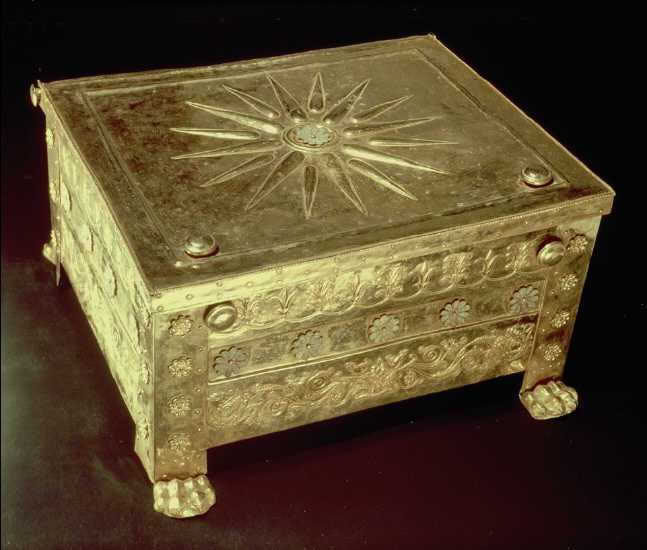
The typical Sun of Vergina is a 16-pointed Sun. It can also be found in other styles: 12-pointed or 8-pointed.
What was the meaning of this symbol??
–In the typical 16-pointed Sun , the 4 rays represent the 4 elements: Earth-Ocean-Fire-Air.
The other 12 rays represent the 12 Gods of Olympus.
You can see the explanation in the following animation :

–In every form, the Sun of Vergina symbolized Virginity: Goddess Athena was a Virgin, so this Sun was associated with her.
We can also find this symbol associated with Apollo.
–All the versions (16,12 and 8-pointed Sun) are associated with another famous Greek symbol, the “Delphian Epsilon”, symbol of Apollo:

The Sun of Vergina became common art design in coins, craters, wall-drawings etc LONG BEFORE the Macedonian royal house (the Argead Dynasty) used it.
After the unification of the Greek (Hellenic) nation under the leadership of Alexander the Great, the Sun of Vergina became the symbol of the Hellenic Ethnogenesis.
In the following replies, you will be able to see some pieces of Ancient Greek art containing the Sun of Vergina, BEFORE THE RISE OF THE GREEK KINGDOM OF MACEDONIA. These sun symbols are found in various Greek places, apart from Macedonia.
Moreover, there will be a small historical flashback, in order to see the evolution of this symbol throught the ages :
2000 BC: This is the time where ancient Greeks first started using the Sun symbol.
It was not standardized yet, it was a early form of the Sun of Vergina:

780BC: The Sun of Vergina has been standardized. The following art work shows the destruction of Troy. We can clearly see the Sun symbol in the warrior’s hump.
It was found in Mykonos island :

The following images are just a small sample, showing the wide usage of the Sun of Vergina in Greek Art:
Spartan Hoplite – 780 BC:

Spartan Amphoreus –
It dates from the 6th century BC, that is, well before Macedonia’s later dominance in the Greek world. In this fine example of ancient pottery, the Sunburst here is not just an incidental decorative motif but rather constitutes the central theme. Its appearance on this household item from distant Sparta, at such an early date, is one of the most compelling pieces of evidence for the panhellenic nature of this ancient symbol. In addition, this item perhaps alludes to a more specific connection between Sparta and her Dorian cousin of the north.
This vase can now be found in the Louvre Museum, Paris. 6th Century BC:

An amphora from the Pontus region (the southern shore of the Black Sea) dating from the second half of the sixth century BC. Priam and the god Hermes lead Hera, Athena and Aphrodite to Paris whose task will be to decide which of these goddesses is the most beautiful. According to the legend each of these goddesses made offers to Paris so that they might win the contest. Hera promised to make him ruler of the world, Athena vowed that he would never be vanquished in battle. Paris eventually chose Aphrodite as she promised him the love of Helen, the most beautiful mortal woman in the world. The Trojan War was a direct result of this fateful contest:
Exekias was a famous vase-painter and potter of ancient Athens. The scene on this page, from an amphora of the third quarter of the 6th century BC (now at the National Museum of Athens), is one of his most famous works. It is considered one of the finest surviving examples of ‘Black Figure’ vase painting.

Achilles and Ajax, two major Greek heroes of Homer’s Iliad are depicted here relaxing over a game of dice during a lull in the fighting. Achilles has just won; he has just thrown a ‘four’ while Ajax has to accept a ‘three’:
Third Quarter of the 6th century BC:

The cloaks of both these Homeric figures are studded with numerous 8-ray Sunbursts.
The return of Hephestus- 560 BC:
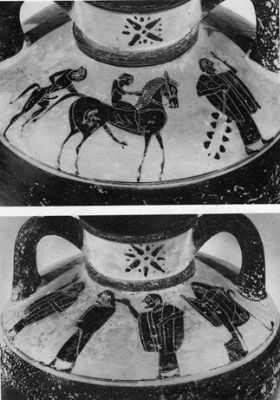
Below is a pyxis (box-like vase) from the second half of the 6th century BC signed by the prolific Athenian potter Nikosthenes. It depicts the hero Herakles with the Gods of Olympus. The seal on the lid of this vessel features the familiar 16-ray Sunburst. Like the garments of Achilles and Ajax on the Exekias vase, the clothes of one of the figures on the front of the pyxis is also adorned with sunbursts:
Athena and Hermes- 540 BC


Heracles and Lernaia Hydra- 525 BC:

Oddyseus blinds the Cyclop, Magna Grecia- 520 BC:

Greek Amphoreus, Magna Grecia- 500 BC

Goddess Athena- 5th century BC:

Hades-the Greek underworld- 5th century BC:

An Athenian citizen-soldier of about 450 BC. He is wearing a linen cuirass (body armour), a style which had largely replaced cuirasses made of bronze by about the middle of the 6th century BC:

The shoulder pieces of his cuirass are decorated with 8-ray Sunbursts. The grotesque face of the Gorgon Medusa, a very common Greek symbol and one of the attributes of the goddess Athena, hangs on his chest.
Heracles and Athena, 480 BC:

Another Attic vase (dated c. 480 BC), shows a warrior wearing an ΅Attic’ helmet and carrying a large, decorated shield. A sixteen-ray sunburst adorns the shoulder piece that is visible:-
c. 480 BC:

The shoulder pieces of yet another hoplite from an Athenian vase of 450 BC above), are likewise decorated with 8-ray Sunbursts. This scene captures the solemn mood of the hoplite warrior’s departure for battle. He is shown clasping his father’s hand while his wife (or mother) carries a phiale (cup) which will be used for the ritual libation of farewell:
450 BC:


Two 16-ray Sunbursts complete the line-up of Greece and the Hellenic pantheon while a further two Sunbursts appear in the top-most scene of the vase.
400 BC:

Greek Hoplite vs Persian Soldier, 4th century BC

The Greek hero Perseus:
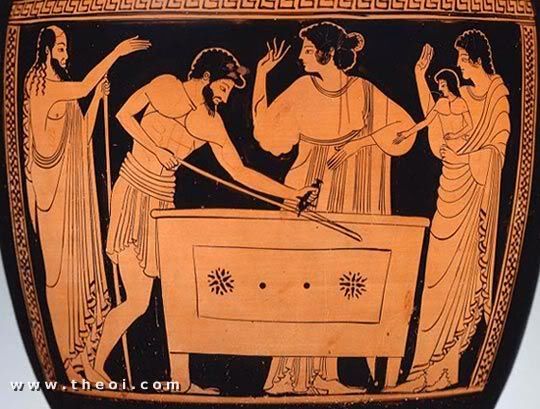
Fourth century BC

Three youths in battles one of whom carries a shield emblazoned with the Sunburst:

Goddess Athena figure 4th century BC:

Athenian Hoplite, 4th century BC:

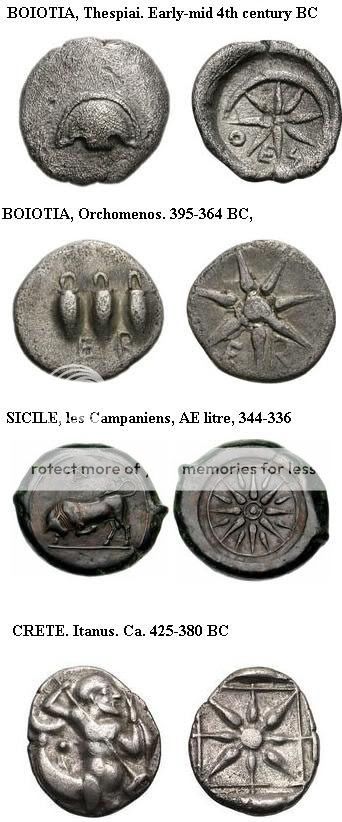
Goddess Athena,4th century BC- Louvre Museum:
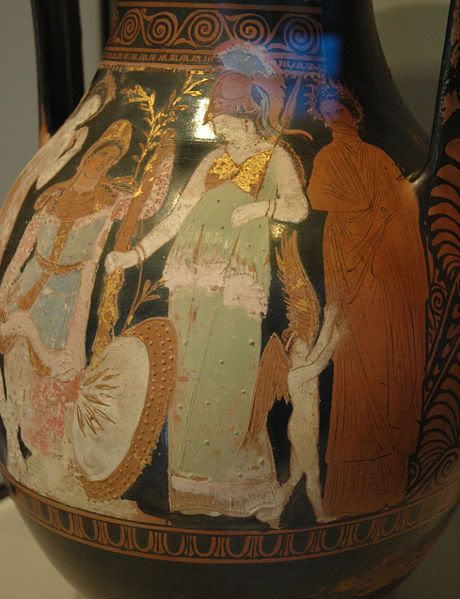
Phrixus and Elli- 4th century BC

One side of a coin from the Ionian island of Kerkyra has a floral motif arranged as a Sunburst. The word KOPKYPAI (Kerkyra) can be read on the periphery:

Helios(God of Sun)- Temple of Athena , Troy:

MACEDONIA IS GREEK



Comments
1 st
VOTED !!!
INTERNATIONAL!!!
Voted!
voted
And let the fake ppl who selfcall theirslves as Macedonians to let us see even one, ONE PROOF that they are ancestors of the real Macedonians.
pest88
a REAL MACEDONIAN!
VOTED !!!
voted from a real Macedonian
o/
voted
v
o perseas les kai paizei mpiliardo einai😃
v+s
go FYROV!!
former yugoslavic republik of VARDASKA!
NOT MACEDONIA!
MACEDONIA IS GREEK!
v oraio arthro.
v
v & s
v+S
http://www.youtube.com/watch?v=5-n_mlKlhhE
v
πολύ καλή δουλειά!!
bravo
v
wraios v
re sy den exoun iq na katalaboun tetoia aytoi einai kollhmenoi sthn istoria tou soros....ti tous deixneis ekei...aparadektos....NOT VOTED 😛
You have made a forgery of history. Greece is Macedonia. And all thouse symbols on the amphoreuses are forged on photoshop! Voted!
bravo!para polu kalo ar8ro.
HARDVOTED!!!
v+s
pest88 - No my friend. They cannot give you proof. They are mentally sick. When they try to steal our history and our historians demanded a debate with their 'historians' - fyromonkeys play deaf. They know very well that everything in their 'history' is a lie. They just hope that by screaming the lies very loud someone may decide to believe that the lies are actually truth. Poor brainwashed bastards.
V+sub
voted !!!
v
[removed]
VOTED!!!!!!
http://www.erepublik.com/en/article/the-ealbanian-and-egreek-issue-fishpeople--1910446/1/20
plz check this out
v+s
hard voted, shouted.
stop propagandonski greeks
u are stealing our history and alaxandar megalexandroski
XENA THE WARRIOR PRINCESS MET SLAVS AND SHE WAS ANCIENT, SOOOO WE EXISTED FROM ANCIENT TIMES
xena is skopje
alaxandar dimitrievic megalexandrofski is skopje
hahahahahahahhahaa lol
v
Votitski !!
Πολυ καλη δουλεια
v
VOTED+SUB
Συγχαρητήρια για το άρθρο!πραγματικά πολύ ωραίο!VOTED από μένα
v+s !
lol. show this to guys in FYROM and they will tell you, you just proved that GREECE IS MACEDONIAN. lmfao
v
ahahahahahahahahahahhaa
Zachs +1
v gia international
Ενα μεγαλο μπραβο στον συνελληνα που ανεβασε ιστορια!!! Φοβερη δουλεια. Και κατα τη γνωμη μου, με το που θα πεσει το αρθρο πρεπει να το ξανανεβασουμε και να το εχουμε διαρκως στα international.
v
ιντερνατιοναλ!!!!!!!!! v
v
Voted